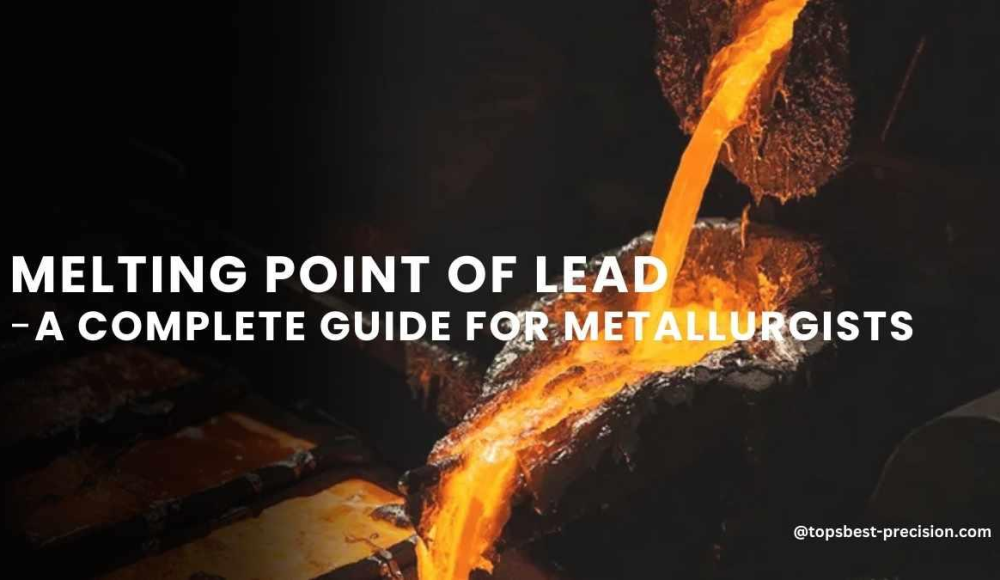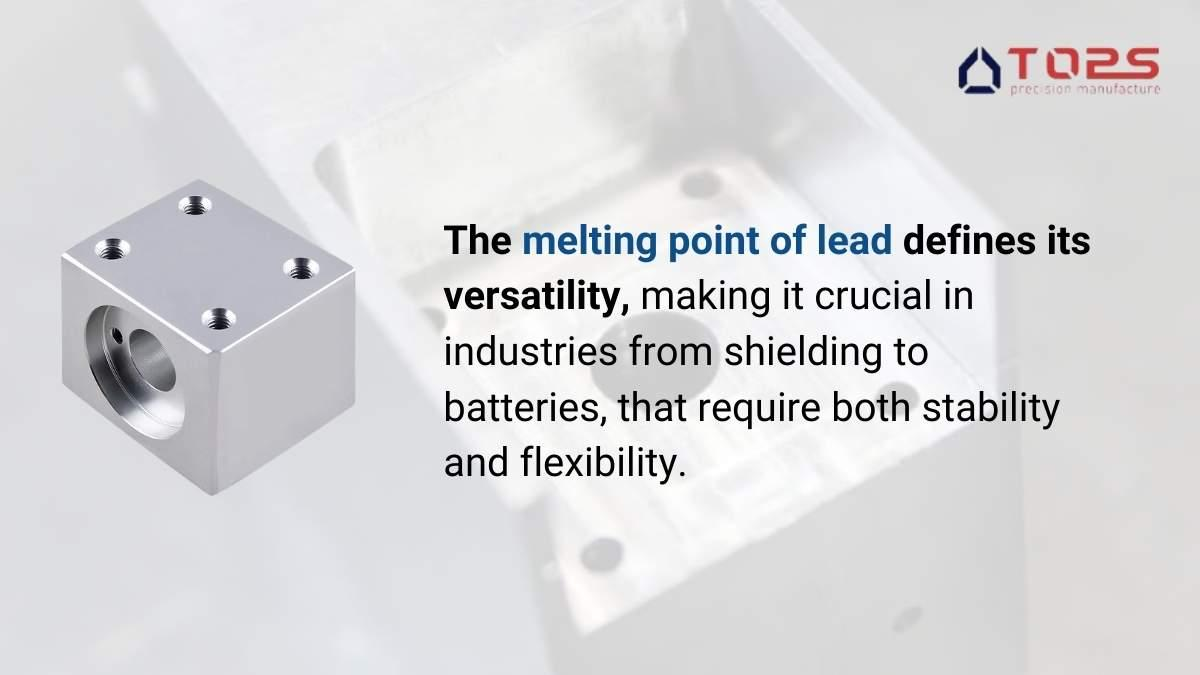هل أنت غير متأكد من نقطة انصهار الرصاص? هذا العامل ضروري جدًا لمشاريع تشغيل المعادن الخاصة بك. من المهم أن نفهم لالتقاط المادة المناسبة لاستخدامها. ومن المثير للاهتمام, الفشل في القيام بذلك يتركك مع إمكانات المشاريع المتأخرة. تؤثر قابلية الرصاص على عمليات الصب واللحام. لذا, الآن دعنا نناقش سبب أهمية درجة الحرارة هذه.
ما هي نقطة انصهار الرصاص?
عادة ما تكون درجة حرارة ذوبان الرصاص أقل, عن 327.5 ج أو 621.5 F. يؤدي الرصاص إلى تغيير طورها من الصلبة إلى السائل, في هذه درجة الحرارة. في هذه الخاصية, يحتاج علماء المعادن إلى معرفة كيف يتفاعل الرصاص للتسخين لاتخاذ القرارات الصحيحة. إنه مفيد عند صناعة السبائك, صب, أو اللحام لأنه يمكّن التحكم في الحرارة.
يتم استخدام الرصاص في اللحام القائم على الرصاص والبطاريات لأنه يحتوي على نقطة انصهار منخفضة نسبيًا. كما يجد تطبيقًا في الصناعات التي تحتاج إلى التحكم في درجة الحرارة لجودة المنتجات التي يتم إنتاجها. تساعد المعرفة أيضًا المهنيين في منع خسائر المواد بالإضافة إلى تقليل أخطاء الإنتاج إلى أدنى حد.
العوامل التي تؤثر على نقطة انصهار الرصاص
تتطلب عملية تعويم الرصاص فهم نقطة الانصهار لأنها تتأثر بعدة عوامل. يكشف القسم التالي عن مثل هذه العوامل الحاسمة: بما في ذلك نوع السبائك, الشوائب, معدل التدفئة, ضغط, وتوزيع درجة الحرارة كلها تؤثر على الوقت الذي ستذوب فيه الرصاص.
1. تكوين سبائك
استخدام سبائك يؤثر على نقطة انصهار الرصاص. قد يتم الحصول على زيادات معتدلة في نقطة الانصهار إذا تم خلط المركب مع المعادن مثل Antimony. تحدد نسبة الرصاص إلى مقدار عناصر صناعة السبائك خصائص الانصهار العامة.
2. وجود الشوائب
وجود عناصر غير مرغوب فيها مثل الكبريت, والزرنيخ, يقلل من نقطة ذوبان الرصاص. يؤثر أي تغيير في درجة التلوث على درجة الحرارة التي يتغير فيها الرصاص من الصلبة إلى السائل وبالتالي يؤثر على دورها في الصناعات.
3. معدل التدفئة
يحدد الوقت المستغرق في الرصاص الحراري كيف يذوب. الانصهار أسرع عند القيام به تحت درجات حرارة عالية بينما بطيئ, تتيح الحرارة الثابتة عملية أكثر اتساقًا. خصوصًا, هذا صحيح في الاستخدامات الأخرى المتخصصة للمواد المعدنية المتخصصة.
4. ضغط
عند ضغوط أعلى, تزداد نقطة الانصهار, والضغوط المنخفضة يمكن أن يقلل من نقطة الانصهار. هذا أمر بالغ الأهمية على وجه التحديد عندما يتعرض الرصاص لأنظمة عالية أو منخفضة الضغط.
5. تدرجات درجة الحرارة
قد يكون توزيع درجة الحرارة داخل المادة سببًا للتغير. إن توحيد الحرارة أمر ضروري عند الانصهار يؤدي إلى تجنب بنية كسر الرصاص خاصة عند العمل بكميات كبيرة.
مقارنة نقطة انصهار الرصاص إلى المعادن الأخرى
يوفر الجدول أدناه مقارنة واضحة لنقاط ذوبان الرصاص و معادن أخرى عبر ثلاثة مقاييس درجات الحرارة: مئوية, فهرنهايت, وكيلفن.
| معدن | مئوية (درجة مئوية) | فهرنهايت(درجة فهرنهايت) | كلفن(° ك) |
| يقود | 327.5درجة مئوية | 621.5درجة فهرنهايت | 600.65 ك |
| الألومنيوم | 660.3درجة مئوية | 1220.5درجة فهرنهايت | 933.45 ك |
| نحاس | 1084درجة مئوية | 1983.2درجة فهرنهايت | 1357.15 ك |
| ذهب | 1064درجة مئوية | 1947.2درجة فهرنهايت | 1337.15 ك |
| حديد | 1538درجة مئوية | 2800.4درجة فهرنهايت | 1811.15 ك |
| فضي | 961.8درجة مئوية | 1763.2درجة فهرنهايت | 1234.95 ك |
| الزنك | 419.5درجة مئوية | 787.1درجة فهرنهايت | 692.65 ك |
| التيتانيوم | 1668درجة مئوية | 3034.4درجة فهرنهايت | 1941.15 ك |
| النيكل | 1455درجة مئوية | 2651درجة فهرنهايت | 1728.15 ك |
كيف تذوب الرصاص?
يخضع المعدن الرصاص لعملية صارمة للذوبان, ويتطلب طريقة مناسبة. تتضمن الطريقة تسخين الرصاص الخام حتى تبدأ في الذوبان. ثم, يتم التعامل مع المادة المنصهرة من أجل الصب, صناعة السبائك, أو تشكيل.
1. تحضير الرصاص
للحصول على تقدم جيد ، يجب أن تكون حذراً للغاية عند جمع الرصاص وقبل ذوبانه. الشوائب على سطح المادة يمكن أن تعيق جودة المعادن عندما يتم ذوبانها. لذا, يعد التنظيف المسبق مهمًا لزيادة مستويات نقاء المنتج النهائي.
2. تسخين الرصاص
يجب تسخين الرصاص إلى نقطة الانصهار, كون 327.5 درجة مئوية (621.5درجة فهرنهايت). يمكن القيام به باستخدام فرن, بوتقة, أو تسخين الحث. في هذه الحالة, يجب تسخين الرصاص ببطء لمنع التبش غير المتكافئ.
3. السيطرة على درجة الحرارة
يجب أن تبقى درجة الحرارة ثابتة طوال الوقت. عندما يتم توصيل الرصاص ، يجب إدارة درجة الحرارة لضمان حالة الرصاص المنصهرة ومنع التصلب. قد يسبب أيضًا الأكسدة والتلوث إذا كانت محمومة.
4. إزالة الشوائب
عندما يذوب الرصاص, أكاسيد وأشكال أخرى من سطح التلوث على المعدن السائل. قد يتم القضاء عليها من خلال إجراءات القشط والتدفق. علاوة على ذلك, يمكن أيضًا استخدام عوامل التدفق لجعل الرصاص المنصهر نظيفًا وخاليًا من الخشونة.
5. صب أو صب
بعد ذلك, يتم سكب الرصاص في قوالب لإلقاء الأشكال والمنتجات المختلفة. لذلك يجب مراقبة تدفقه لتجنب الانسكاب والمخالفات على سطح المصبوب الناتج.
6. التبريد والتصلب
بمجرد سكبها ، يتم تعيينها بسرعة لأن الرصاص لديه نقطة انصهار منخفضة نسبيًا. قد يكون لمعدل التبريد تأثير على بعض خصائص المنتج النهائي, لذا, يجب تنظيم عملية التبريد في التطبيقات الصناعية.
سبائك درجات مختلفة من الرصاص
يؤدي خيوط درجات متفاوتة عناصر مختلفة. تحدد نقاء الرصاص سلوكها في هذه العملية, نقطة انصهارها, وتطبيقه في مختلف الصناعات.
1. الرصاص النقي (99.9% يقود)
تم العثور على الرصاص النقي ليحتوي على درجة عالية من النقاء ونقطة انصهار منخفضة نسبيا من 327.5 درجة مئوية (621.5درجة فهرنهايت). يشتمل الصف أيضًا على خاصية تدفق جيدة تتيح معالجتها بسهولة وموحدة.
2. سبائك الرصاص
تتألف سبائك الرصاص (PB-SN) والرصاص (PB-SB) سبائك. تختلف نقطة انصهار السبائك مع التكوين. تستخدم هذه السبائك لأغراض خاصة على سبيل المثال في لحام PB SN أو للبطارية PB SB.
- الرصاص (PB-SN) سبيكة: تعتمد نقاط الانصهار على النسبة, لكنها في نطاق 180-300 0ج (356-572 F) بسبب القصدير.
- الرصاص (PB-SB) سبيكة: بالمقارنة مع الرصاص الخالص ، فإن هذه السبائك لديها نقطة انصهار أعلى, عموما تتراوح من 325 ل 340 درجة مئوية (617 ل 644 F) اعتمادا على النسبة المئوية لانتيمون.
3. الرصاص المعاد تدويره
الرصاص الخردة, تستخدم في إنشاء الرصاص المعاد تدويره, قد تحتوي على شوائب قد تشويه خصائص ذوبانها. يجب التخلص من هذه العناصر غير المرغوب فيها من خلال عملية التدفق. وبالتالي فإن الرصاص المنصهر لا يغير معالمه.
4. الرصاص للبطاريات (PB-CA)
الرصاص المستخدم في صناعة البطاريات, وخاصة في بطاريات الرصاص الحمضية, قد تحتوي على الكالسيوم (PB-CA) وغيرها من الإضافات السبائكية. ومع ذلك، يمكن أن تتقلب درجة الرصاص الصلبة إلى حد ما ولكنها عادة ما تكون ضمن درجات قليلة من قيمة الرصاص النقي التي تبلغ حوالي 327.5 درجة مئوية.. كما هو الحال مع أي عملية حرارية, يجب توخي الحذر أثناء عملية الذوبان لمنع بدء التفاعلات الجانبية غير المرغوب فيها.
5. تقدم التدريع للإشعاع
يستخدم الرصاص التدريع في الحماية من الإشعاع. عادة, فهو نقي كيميائيًا وقد يحتوي على آثار صغيرة من إضافات صناعة السبائك. تتم إعادة صهر هذه الدرجات من الرصاص بشكل عام عند درجات حرارة أقل قليلاً من درجة حرارة الرصاص النقي, على الرغم من السيطرة عليها لمنع الأكسدة.
دور نقطة انصهار الرصاص في القطاعات المتنوعة
خصائص الرصاص, بما في ذلك نقطة الانصهار, تؤثر على مختلف الحقول. تؤثر هذه الخصائص على كيفية إدارة الصناعات وتحويلها. يساعد فهمهم في منع الأخطاء وزيادة الكفاءة
1. اللحام والإلكترونيات
الرصاص شائع في اللحام. تجعل درجة حرارة الانصهار المنخفضة من السهل لحام المكونات الإلكترونية معًا دون المخاطرة بتلف الأجزاء الحساسة من المكونات. أنها توفر اتصالات كهربائية مضمونة في لوحات الدوائر.
2. بطاريات حمض الرصاص
في تصنيع البطارية, لدى الرصاص نقطة انصهار منخفضة لتسهيل سبائك لوحات البطارية. يجب الحفاظ على درجة الحرارة المناسبة لتجنب الأكسدة, وبدوره, تحلل جودة اللوحة.
3. التدريع الإشعاعي
يستخدم الرصاص في التدريع الإشعاعي بسبب كثافته العالية. تتيح نقطة الانصهار المنخفضة استخدامها لإنتاج صفائح سميكة. يعطي ضمان الحماية, خاصة في الصناعات الطبية وغيرها.
4. الصب والقولبة
من السهل جدًا. يوفر إمكانية الحصول على أشكال معقدة وأجزاء صغيرة في الأحجام اللازمة. تم العثور على الاستخدام الأكثر شيوعًا للرصاص في الأنابيب, المباريات المنزلية, والبرونز الزينة.
5. تصنيع الذخيرة
نقاء الرصاص أمر بالغ الأهمية في تصنيع الذخيرة بسبب نقطة الانصهار. إنه يسهل صب الرصاص ذي الحجم والوزن القياسي. تضمن العملية مقذوفات عالية الأداء للأسلحة النارية.
ملخص
نقطة انصهار الرصاص أمر بالغ الأهمية لاستخدامات صناعية مختلفة. يؤثر على أنشطة مثل اللحام, صب, وتصنيع البطاريات. يساعد فهم هذه الممتلكات في تحقيق نتائج دقيقة وجودة عالية. عن طريق الحفاظ على درجات الحرارة المناسبة, يتم التحكم في خصائص وتوحيد السبائك المذابة.
في قمم الدقة نحن نقدم يؤدي عالي الجودة إلى متطلباتك الدقيقة. من الضمان أن يتم التعامل مع كل مشروع نعمل عليه بشكل احترافي ، مع الكثير من الاهتمام بالتفاصيل للوفاء بأعلى خدمات نقدمها.





1 فكرت في "نقطة انصهار الرصاص – دليل كامل لعلماء المعادن المعادن”